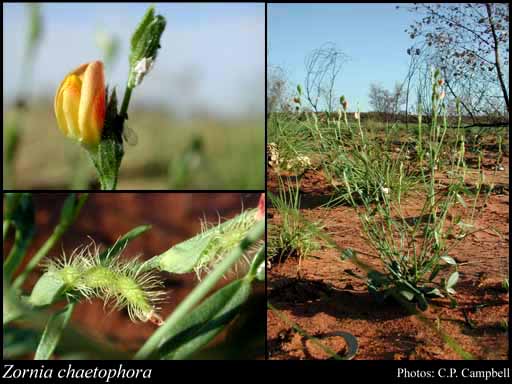- Reference
- Trans.& Proc.Philos.Inst.Victoria 3:56 (1859)
- Conservation Code
- Not threatened
- Naturalised Status
- Native to Western Australia
- Name Status
- Current
Erect, multi-stemmed perennial, herb, to 0.5 m high. Fl. yellow, Feb to Apr or Aug to Sep. Red sand. Flats, rocky ridges.

Scientific Description
Erect, herb. Stems terete, not spiny, glabrous; pustules or glands absent. Leaves or phylloclades clearly present, compound, alternate, not continuous with stem, 40-52 mm long, hairy, with simple hairs, flat with flat margins; margins entire; tubercles absent, terminal leaflet absent; pustules or glands present. Stipules present and persistent to older leaves. Pedicel absent (flowers sessile). Bracteoles absent. Calyx 3.5 mm long, not accrescent, hairy, with simple hairs, ribless; pustules or glands absent. Corolla 5.5-11 mm long, uniformly coloured, yellow; claws present; standard 5-7.5 mm long, glabrous, not auriculate, wings 4.5-6 mm long, not auriculate, keel 5-6 mm long, beaked, not auriculate, glabrous. Stamens ten. Fruit indehiscent and not splitting into sections, 15-20 mm long, 3-4 mm wide, constricted between the seeds, hairy, with simple hairs. Flowers in February, March, April, August and September. Occurs in the Northern and Eremaean Botanical Province, in the Great Sandy Desert, Pilbara, Northern Kimberley and Dampierland IBRA regions.
Distribution
- IBRA Regions
- Dampierland, Great Sandy Desert, Northern Kimberley, Pilbara.
- IBRA Subregions
- Fitzroy Trough, McLarty, Mitchell, Pindanland, Roebourne.
- Local Government Areas (LGAs)
- Broome, Derby-West Kimberley, East Pilbara, Port Hedland, Wyndham-East Kimberley.